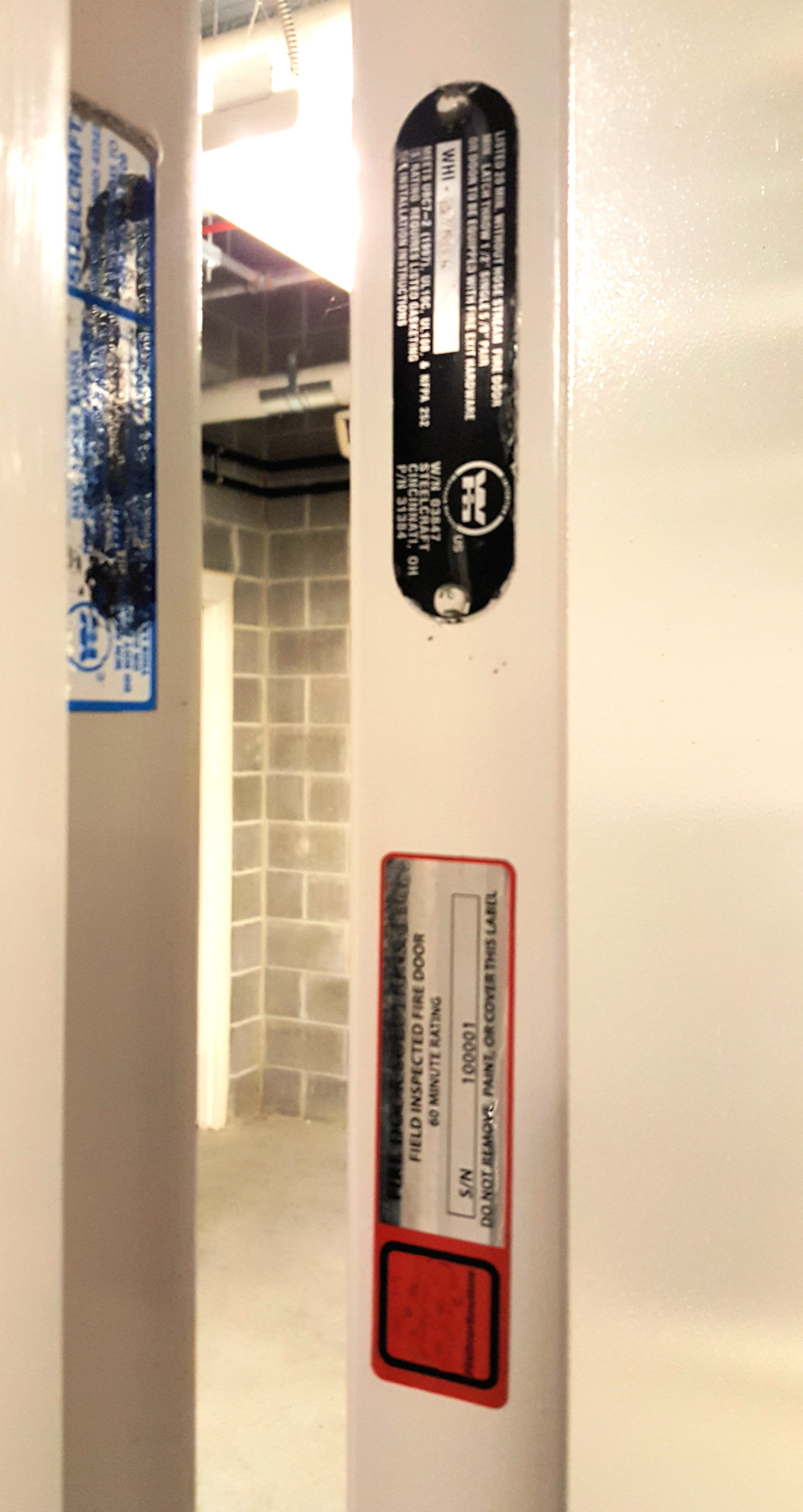 A fire protection engineer recently sent me this photo from a health care facility, which shows a fire door assembly with the original 20-minute label on the door. A new “field inspected fire door” label has been added below the original one, stating that the door is labeled for 60 minutes. Today’s Quick Question is this:
A fire protection engineer recently sent me this photo from a health care facility, which shows a fire door assembly with the original 20-minute label on the door. A new “field inspected fire door” label has been added below the original one, stating that the door is labeled for 60 minutes. Today’s Quick Question is this:
Can an existing fire door be labeled in the field for a higher rating than what it was originally listed for?
Since the opening in the photo happens to be a Steelcraft door and frame, I asked our engineer for her opinion, based on our fire door and frame listings. She responded that a door can not typically be field-labeled as a door with a higher rating – at least not without further investigation. Although technically a hollow metal door may carry a rating of up to 3 hours, there are modifications such as vision lights and hardware preps that affect the maximum allowable rating.
The door in the photo would have been listed in our records as a 20-minute door, not a 60-minute door. It would be difficult or impossible for a field-labeler to know whether a particular door or frame would meet the requirements for a rating different from what was on the label. If a change in the rating was required, it would likely involve the listing lab (UL, Intertek, etc.) to determine whether the change could be made as a field modification, defined by NFPA 80.
For many years, nationally-recognized testing laboratories have provided field labeling services for installed assemblies when the original labels have been painted or removed, or where doors or frames have been modified. A section was added to the 2016 edition of NFPA 80, addressing field labeling of existing fire doors, shutters, and windows, as there has been an increased demand for these services along with the increased enforcement of annual fire door assembly inspections.
In short, the new section mandates the following:
- Individuals or companies performing field labeling must be certified or listed, or individuals or companies must be representatives of a labeling service that “maintains periodic inspections of production of labeled equipment or materials and by whose labeling the manufacturer indicates compliance with appropriate standards or performance in a specified manner.”
- Individuals must provide proof of qualifications to the AHJ prior to performing the field labeling.
- Field-applied labels must include, at minimum, the words “field inspected” or “field labeled”, the words “fire door” or “fire door frame”, the marking of a third-party certification agency, the fire protection rating, a unique serial number (if provided by the listing agency), and the fire test standard designation to which the assembly was tested.
- If a fire door assembly is required in a location where a non-fire-rated assembly was installed, NFPA 80 includes some requirements and limitations related to that process.
Hopefully, we will see further guidance on field labeling in the future from the test labs and organizations representing manufacturers of fire doors. Until then, any questions about field labeling should be carefully considered by the manufacturer and the AHJ to ensure that the labels applied in the field are accurate.
If you have insight or experience with this issue, please share it by leaving a comment!
Thank you to Matt Ruhrer of HDR Inc. for the photo!
You need to login or register to bookmark/favorite this content.





It would seem that if the wall, door, frame, and all hardware components meet the criteria of a higher rating, then it would be okay to label the door and/or frame as such.
But I would also think that in this particular case, you would want to remove the 20 Minute label to avoid later confusion.
Hi Lori. Sometimes doors leafs are labeled incorrectly at the factory. If the factory learns of the error after the doors have been installed, they may ask the listing agency to evaluate the installed doors against their procedures and put on a field label that corrects the problem. That may have been what happened in your situation, but also maybe not. There’s a telenovela behind every field labeling.
Hi Lloyd –
Yes, that is a possibility, but there should be documentation of a change like that. If I saw a new label with different information I would want to see the paper trail.
– Lori
In a word No …. I have seen doors with labels painted over and disqualified as a result . Doors modified in the field with vision kits different and additional hardware. The problem is not enough qualified trained inspectors and too much vague interpitation of codes
Field relabeling
Without supporting paperwork to prove that the inspected door -was tested at a higher fire-rating value… then the label shows …it’s a non-starter. It’s non- compliant …without the supporting paperwork from the Door manufacturer. The paperwork must show clear evidence that these doors by serial number were constructed as the same group that was tested to a higher Fire-rating, as constructed. IF you get that…the manufacturer might supply a new label.
My 2 cents – ON THE SUBJECT OF FIELD RELABELING.
When it comes to inspecting Fire Doors… we have installed, maintained, and have “Annually Inspected & Tested” quite a few fire-doors over the last 23 years… The painted over, or non-legible Fire Door label …in older buildings is one of the most prevalent fire code violations…that we or others encounter.
When it comes to correcting this violation…” field relabeling,” in my opinion… is the least effective, most over cited, over-rated, non-compliment enforced, and least beneficial violation( when it comes to fire protection). I think it’s because of it so easy to spot and write-up.
The principal certification firms who do “relabeling” – do absolutely nothing that exceeds our complete Annual Fire Door Inspection… if anything, they do less, because we supply much more to a client then they do… and they charge twice to three times what we do.
e.g., We currently have a large Condo- inspection client. The building is, 37 years old with 402 “inspected” doors, 231 have painted over labels. In our quest for relabeling quotes – the lowest price from three major certified “relabeling companies” was $ 18,942. ($82.00/ea). After the clients reviewed the proposals, they were not “happy campers” they could not believe the prices- We had presented the proposals, as received (with no kick-back to us or additions). The clients informed me that they intended to challenge the AHJ’s citation in court! I decided to intercede a set up a meeting with the “rigid” AHJ, the Fire Chief, and the City Attorney. I showed them the Florida Law that states – “if a Code ruling is resisted “as over-reaching” – the code enforcement officials, must prove to the court, that there is a COST = BENEFIT (to the County/City from fire prevention, fire extinguishing, fire safety, etc.). During the meeting, It appeared, there was no interest in going to court and attempting to defend the benefit of field relabeling in preventing or extinguishing a fire. The AHJ withdrew the infraction. The only obvious benefit is to the company doing the relabeling. 98% of the written explanations for why it’s necessary …in the vast majority of cases, relabeling only amounts to “Eyewash” and NO “true” provable value. In my humble option-
If a door does NOT have a label can I assume that it is NOT suppose to be a fire door? I am struggling to know which doors are fire doors and which are not? We are a multi-occupancy facility – apartment, residential board and care and healthcare.
Hi Alena –
It’s not really safe to make that assumption because sometimes the labels are removed or painted over. It can depend on where the door is located and how old the building is. If you’d like to email me, I can put you in touch with your local ACE (Allegion Code Expert). lori.greene@allegion.com
– Lori
The Warnock Hershey doors are labeled but the frames are just stamped with the w/h do those have to be labeled as well?